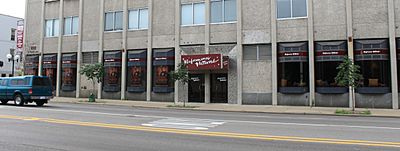Performance Network Theatre facts for kids
 |
|
| Address | 120 E Huron Ann Arbor, Michigan USA |
|---|---|
| Type | black box/proscenium |
| Capacity | 140 seats |
| Opened | 1981 |
| Closed | 2015 |
| Years active | 35 |
The Performance Network Theatre was a professional theater in Ann Arbor, Michigan. It was founded in 1981 and for 35 years was a popular place to see plays. The theater showed many types of performances, including dramas, comedies, and classic stories.
Many of the plays shown at the theater were brand new to audiences in Michigan. The theater also hosted festivals, music events, and programs for children. At the end of 2015, the Performance Network Theatre closed for good.
Contents
History of the Theatre
The Performance Network Theatre started in 1981 as a small arts group founded by David Bernstein and Jim Moran. In the beginning, it was a place for writers and artists to create new and experimental plays.
By the 1990s, the theater grew and became more professional. In 1997, it signed a contract with the Actors’ Equity Association. This is a union for professional actors. This step allowed the theater to hire experienced actors and show more famous plays.
In 2000, the theater moved to a new, modern building in downtown Ann Arbor. Its main stage, the Shure Theater, was a small space that could seat about 140 people. This made the shows feel very personal and close-up for the audience.
For many years, the theater was very successful and won many awards. However, in 2014, it began to have money problems. Despite efforts to raise money and bring in more visitors, the theater could not pay its bills. In December 2015, the Performance Network Theatre announced it was closing.
What You Could See and Do
The Professional Season
Each year, the theater had a "professional season" with five to seven main plays. These seasons often included a mix of different types of shows, like a classic play, a musical, and a brand-new play that had never been seen before. People could buy tickets for the whole season at a discount.
Learning About Theatre
The Performance Network Theatre also offered programs for people who wanted to learn how to work in theater.
- Apprenticeships: This was a year-long program where people could get paid to learn. They got hands-on training in everything from managing the stage to marketing and building sets.
- Internships: Interns could choose a specific area of theater to focus on, like working with the audience or helping with the technical parts of a show.
Famous Plays and Shows
Over its 35 years, the theater put on hundreds of shows. It was known for showing a mix of classic plays and new, exciting works. Some of the well-known plays performed there include:
- Who's Afraid of Virginia Woolf? by Edward Albee
- Driving Miss Daisy by Alfred Uhry
- The Glass Menagerie by Tennessee Williams
- A Little Night Music by Stephen Sondheim
- Richard III by William Shakespeare
- Little Shop of Horrors
- The Seafarer by Conor McPherson
- Fences by August Wilson
- Amadeus by Peter Shaffer
- A Doll's House by Henrik Ibsen
- Man of La Mancha
- Copenhagen by Michael Frayn
- Picasso at the Lapin Agile by Steve Martin
The theater also performed many "Michigan Premieres," meaning it was the first time those plays were shown in the state.
Awards and Recognition
The Performance Network Theatre was highly respected and won many awards for its excellent shows.
- It received national awards from the Edgerton Foundation for helping to create new American plays.
- Local magazines and newspapers, like the Metro Times and Current Magazine, often voted it "Best Theatre."
- The Detroit Free Press gave the theater special awards for its important contributions to the arts.
- It won dozens of "Wilde Awards," which honor the best professional theater in Michigan. These awards were for acting, directing, set design, and best overall shows.
Groups and Supporters
The theater was a member of several important arts groups, including the Theatre Communications Group (TCG) and the National New Play Network (NNPN). It was supported by the Michigan Council for Arts and Cultural Affairs and the National Endowment for the Arts, which showed its importance to the arts in both Michigan and the United States.

